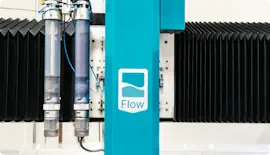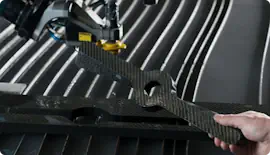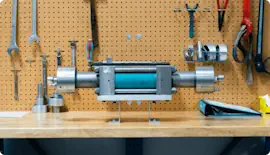What Are Some of the Cool Things Waterjet Can Cut?
The 5 Most Common Waterjet Questions - Part Five of Five
For those doubting water as an effective cutting tool: think again.Waterjet technology is known for its power and favored for its ability to split just about any material in half. We’ve gone over this before – the combination of 60,000 Pounds per Square Inch (PSI) of pressure and abrasive garnet turns a seemingly benign hydraulic stream into a serious power tool.
Waterjet can cut through stone, metal, and other formidable materials. But what else? As the final article in our 5-part series on the 5 Most Common Waterjet Questions, we address the question everyone has on their minds, what are some of the coolest things you’ve seen waterjet cut? Buckle up, we’re about to share some of our favorites.
24” Thick Steel
If there’s any material that is seemingly impervious, it’s steel. Steel is made of iron and carbon and one of the most-used components in industrial fabrication. However, it’s no match for waterjet.Waterjet’s tempered, consistent stream has the ability to easily cut through 24 inches – yes, two feet – worth of steel. Don’t believe us? Check out the image below of a 24-inch thick, contoured piece of steel cut in the dry docks. Amazing!

Food
A waterjet isn’t a staple in the kitchen. But that doesn’t mean it’s an impractical culinary tool.In fact, waterjet cutting is approved by the United States Department of Agriculture and is more sanitary than using a knife. No blade means no bacterial transfer from blade to food. Meats, poultry, fish, produce, pastries, and frozen foods can all be cut with a waterjet.
In industrial settings, meat, vegetables and even candy bars – yes, candy bars – are cut using waterjet machines. Waterjet offers consistent cut sizes and efficiency, making the machine an extremely helpful tool in the food industry.
Gourds represent another, albeit interesting, use case: Watch a waterjet carve this pumpkin in under 30 seconds.
Extremely Small Materials (Microcutting)
We often think about all of the large, impressive things waterjet can cut. But its dexterity dealing with small pieces of material is just as impressive. Microcutting refers to waterjet’s ability to cut tiny pieces of materials – ranging anywhere from 0.001″ to 0.125.”Microcutting applications include watchmaking or creating circuit boards and the production of small electronics. And just because you’re cutting at microlevels doesn’t mean you have to sacrifice precision or repeatability. In fact, our NanoJet waterjet solution is specifically designed as a highly accurate, small format waterjet machining center.
Check out the image below for scale!

Art
Waterjet projects often conjure up images of industrial applications: the creation of automotive parts, turbine blades, fiberglass components. But the technology can also be used to create beautiful pieces of art.Waterjet’s precise cutting ability makes it a perfect tool for producing intricate inlays with ceramics, metal, and other materials. Dynamic or Dynamic XD waterjet cutting heads make extremely accurate cuts that allow artisans to produce stunning pieces in 2D or 3D.

Check out this aluminum lamp created with waterjet.Stained glass windows are another common application where waterjet creativity shines. Victoria Balva creates beautiful designs with glass using waterjet. Check out her Instagram page.
But it’s not just functional pieces – waterjet is a common tool found in the workshops of artists creating stand-alone two- or three-dimensional displays. Wall décor and jewelry can also be cut with waterjet.
Check out this cool piece of art, a robot that Intelligent Cutting Solutions put outside of its headquarters in Connecticut.
Knife Blades
We already know that waterjet can cut steel – which is a feat in itself.But one of its more interesting use cases is knife cutting. Waterjet is used to create the blades, handles, and lock faces on knives. Again, because it can create intricate cuts – think Dynamic or Dynamic XD cutting heads – it gives manufacturers a plethora of options when it comes to creating artisan-crafted knives.

No matter the blade type – convex, concave, hollow, etc. – waterjet creates beautiful finishes. Check out some of the designs waterjet has created for Prince Customs.
And Just About Anything Else
Check out the Waterjet Channel on YouTube if you haven’t already. It houses more than 300 videos of waterjet cutting through just about anything you can think of. And one of the coolest videos on the site features a 60,000 PSI waterjet cutting through an anvil.Before the operation begins, the anvil is captured in slow motion crushing a carton of eggs and a bottle of pop among other things; these stunts alone make the video worth watching. But, of course, seeing the stream break the anvil in half is main event.
The Waterjet Channel makes clear that just about anything under the sun can be cut through with the help of a waterjet. It covers what some might consider practical, industrial uses – a piece of railroad track, for example – to applications created completely for the heck of it. A more frivolous application on the channel includes slicing a projector in two.
Abrasive waterjet is powerful, precise and, unlike other cutting mechanisms, able to make cuts without creating heat-induced damage that leads to the need for secondary finishes. It creates minimal kerf and its technology has developed to the point where it’s able to prevent stream lag and taper.



